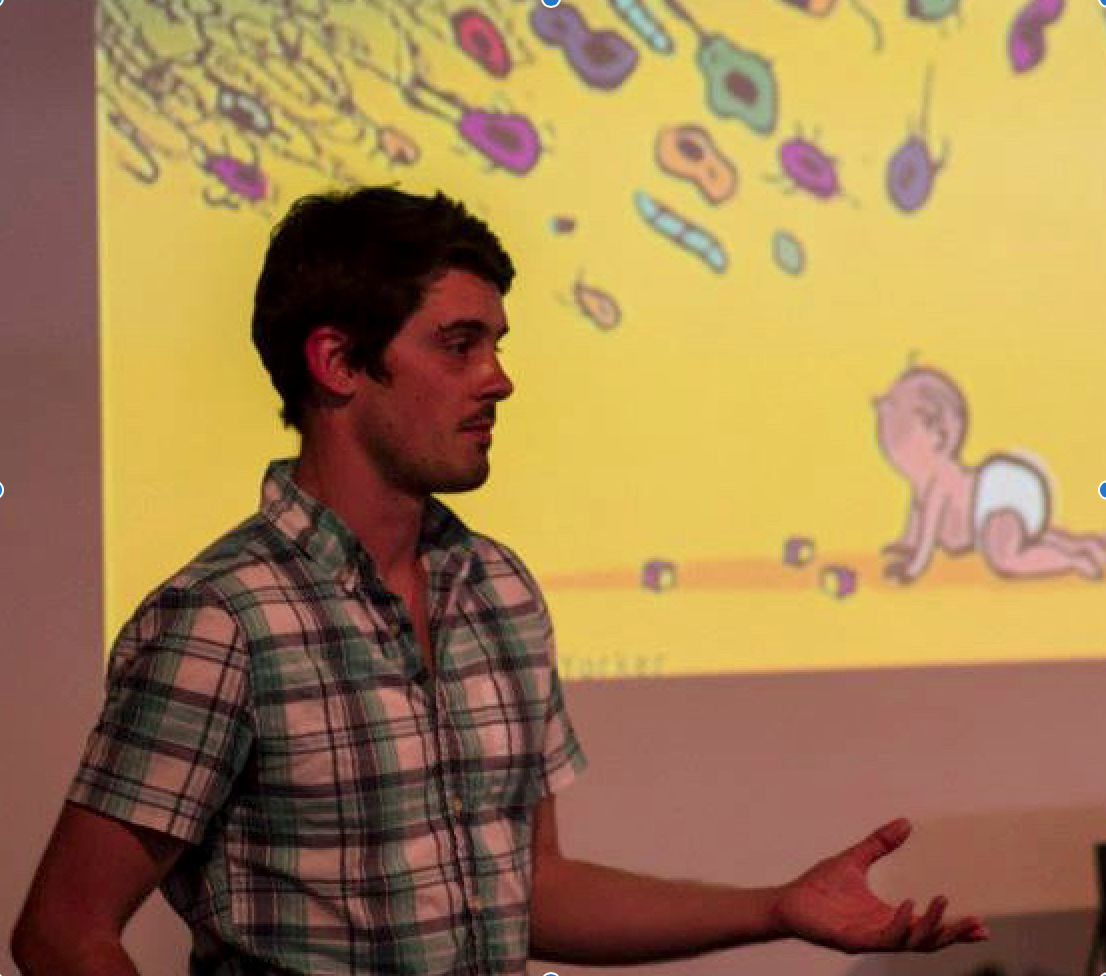Microbes – or microorganisms: creatures so small you can’t see them – are everywhere. Some of them live on the surfaces of almost everything you touch. Others also live on and inside of you, from the surface of your skin to the innards of your gut.
You may have heard of dangerous bacteria like Salmonella and E. coli, but many other microbes are essential to us and our ecosystem. In fact, without microorganisms living inside your stomach, you wouldn’t be able to digest your food. The world of bacteria and other microbes fascinates Microbiologist Sean Gibbons, whose exploration of that world takes him out of the lab and into people’s homes and public restrooms.
As a child, Sean loved magic. He made potions in the backyard and wanted to be a wizard or sorcerer when he grew up. But when he learned about the atom in first grade, his entire world changed. He realized that science was like grownup magic. Science can allow us to understand parts of the world around us, shows us how much we don’t know, makes us curious, and gives us the tools we need to find out more. The more we understand, the more questions we tend to ask, which is why scientists, like artists, tend to be creative and imaginative people. Science has allowed Sean to stay the same inquisitive kid — poking at things, asking questions, and trying to understand the natural world.
Science helps Gibbons explore the world. So do math and computer skills. He uses math – especially statistics – daily in his work. Scientific research and studies produce a huge amount of data. Using statistics to present your results and tell a clear story is extremely important. Gibbons also emphasizes the important of coding – using computers and their languages in service of science.
When your parents or teachers taught you basic hygiene when you were younger, you might have thought that all there was to being clean and healthy was washing your hands, showering or taking a bath, and avoiding germs and other dirty things. However, there is some myth mixed in with these lessons so often taught to young kids.
You might assume that public bathrooms are gross and dirty, full of germs and diseases. Gibbons and his co-authors address this concern in a famous study they wrote on the growth of microbes in public restrooms. In it, he and other researchers explore how communities of bacteria and virus shift over a moderate period of time.
They began by cleaning restrooms and then takings swabs off of soap dispensers, toilet seats, and floors every couple of hours for two months. In all, Gibbons and his co-authors found more than 77,000 distinct types of bacteria and viruses! The most common microbes living in the public bathrooms were fecal bacteria – from poop – and Staphylococcus (Staph), a type of bacteria commonly found on the skin.
Although the bathrooms were regularly cleaned, this cleaning did not significantly reduce the population of microbe communities. But before you decide to never use a public restroom again, you should know that the study concluded that having a “healthy community of good – or even just neutral – microbes can crowd out the bad ones . . . we need [all different types of] bacteria” (NPR). This does not mean that we shouldn’t wash our hands after using public bathrooms, but many of our fears about the dangers of bacteria, germs, and disease in public restrooms have been based on misconceptions about the symbiotic relationship between us and microbes. We need microbes as much as they need us.

In his more recent work, Gibbons has been focusing on how the ecology of the human body affects the treatment of disease. He and his colleagues explore the microbiomes – groups of microbes in a particular environment – that live inside us.
In a 2015 study, Gibbons looked at the relationship between gut microbes and circadian rhythm. Circadian rhythm is the internal clock that our body runs on that helps control what time of the day we sleep, eat, and wake up. It is known that our circadian rhythm depends on exposure to light – which is why we are awake during the day but sleep at night. Gibbons’ study found that gut microbes also play a large role in our circadian rhythm and metabolism, the process by which the body breaks down food for energy.
He and his colleagues studied two groups of mice. The first group had a normal set of gut microbes. These mice had a regular, daily circadian clock cycle but gained weight on a high-fat diet. They also studied a second group: mice that were “germ-free.” This group had a disrupted, irregular cycle but did not gain weight on the same diet. The results of this study suggested that gut microbes play an important role in how people gain or lose weight.
Whether they’re on the floors of public bathrooms or in our stomachs, microbes are an essential part of the world we live in. Grab a microscope or go to sites like this one to find photographs and video footage of these tiny critters at work.



